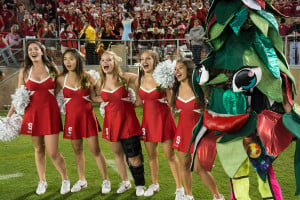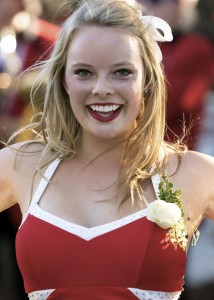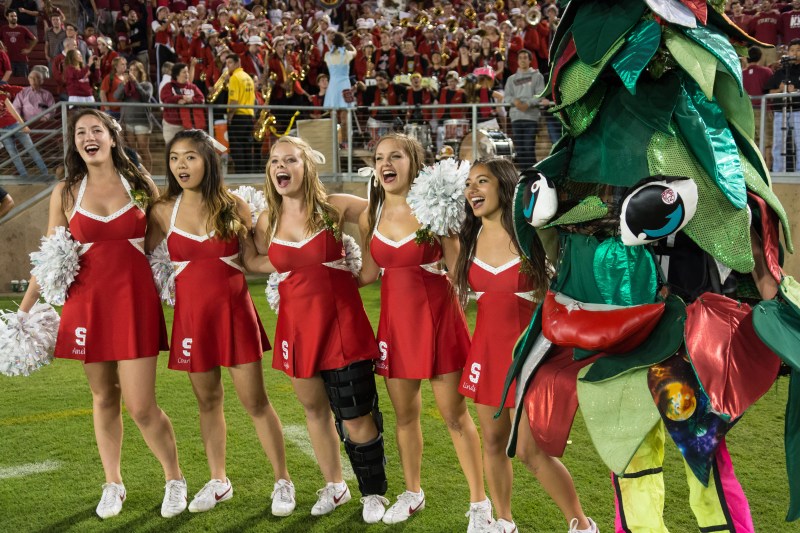With a month of intensive training under their belt and nearly 30 dances in their repertoire, the 2013-14 Stanford Dollies entered the season’s first football game against San Jose State with confidence, excitement and lots of adrenaline.

“All of the previous Dollies had told us about that first moment when you walk into the stadium,” said Leigh Kinney ’16, or “Dollie No. 3,” as she is known within the Band. “You are on the field and you start to see all of the seats filling up. It’s this promising moment when you realize that this is your time to shine.”
Although the Dollies perform for almost every different sport at some point during the year, football season is the true cornerstone of their season.
“We had prepared for months and months and just put our hearts and souls into this training,” Kinney said. “We were totally ready…knowing that we were there for a reason, we were there to support the game and we were taking our presence as our year for the Dollies.”
The Dollies’ evening began with the famous “Come Join The Band” dance, and then moved quickly into their pregame field show. The first song of the show was a success and the Pac-12 Network cameras centered on Kinney the entire time—as Dollie No. 3, she dances right in the middle.
The Dollies ran to the far side of the field to perform their second dance, and returned to the student section for their third dance titled “Battle Without Honor or Humanity.”
It was during this song that the night took a horrible turn.
“We were halfway through the dance and I was jumping left out of a double right pencil turn when all of a sudden I heard this pop,” Kinney said. “I fell down and crumbled to the ground. My immediate reaction was ‘I can’t believe I just fell in my first pregame show,’ so I tried to get back up as quickly as possible.”
“As soon as I stood up though, I realized I couldn’t hold my weight. When I had heard the pop, I knew something was wrong, but when I couldn’t even stand up, I knew something was terribly wrong.”

The football trainers at the stadium told Kinney that she had a dislocated patella, but two days later, she found out that she had torn her anterior crucial ligament (ACL), a much more severe injury.
“When I heard [the news], I couldn’t control myself. I was sobbing uncontrollably on the doctor’s table,” Kinney said.
The first decision Kinney faced was when to have surgery.
Her doctor — who also treated San Francisco Giants catcher Buster Posey — explained that he sometimes prescribes athletes with aggressive physical therapy and a special brace that allow them to play their sport temporarily without an ACL as a way to avoid immediate surgery.
“At first, I was really willing to take that risk,” Kinney said. “It gave me the option to still dance and I felt like I could find the strength to compensate for not having an ACL.”
Despite the risks associated with dancing on a torn ACL such as further damage to the knee, Kinney was back at Stanford’s next home football game on Sept. 21. She was able to freestyle dance during some of the songs and when she wasn’t dancing, she would step to the side and photograph the other Dollies performing.
“At first, it was kind of hard to watch them, because I was watching them get to do everything that I knew I should be able to do and should be doing with them,” Kinney said. “[But] I was pretty quickly able to put that aside and realize how wonderful it was that I had the opportunity to be there in the first place.”
As Kinney reached the end of her third week of physical therapy, however, she decided to reconsider her decision. She said that while she was be able to do a lot of Dollie moves, she realized that her knee was too weak to execute jumps, turns and kicks, which are a huge portion of the Dollies’ movement.
In late September, Kinney had a talk with the other Dollies and Band Assistant Manager Ben Rosenberg ’14, about her next steps.
“I think I had been so excited about the option of getting rid of my injury, that I forgot that I had a body to think about and a future to think about,” Kinney said. “Our talk got me more excited about surgery and the prospect of being on the upward trend and actually healing for good.”
The four remaining Dollies, Amelia Chen ’16, Lindsay Fiorentino ’16, Heather Glenny ’16 and Courtney Yang ’16, also had to decide how to adjust moving forward — and quickly, given a scheduled performance at a volleyball game the following week.
Whether or not to find an alternate Dollie or a Dollie from the previous year to fill in became a point of contention between old Dollies, band management and the new Dollies. Ultimately, the current Dollies and Rosenberg decided to stick with the original group.
“My Dollies and Ben really fought hard for me and I’m pretty sure my Dollies would boycott if I were to be replaced,” Kinney said. “That unending support has meant the world to me. And that’s all I really need.”
“It’s a lot more than just having five dancers,” Glenny said. “It’s about having five dancers who love each other and who are so close — it’s really a team thing. The 2013-14 Dollies will always be us five; it’s just that right now one of us isn’t dancing.”
Kinney had surgery on Oct. 4 and is more determined than ever to get back to dancing with her Dollies. She said that she is thankful she had her surgery now, because the potential to get back to dancing with the Dollies is motivating her to push through physical therapy.
Kinney said that even though it takes most people nine months to return from an ACL tear, she’s trying to return to dancing within three —a timeline that coincides nicely with football bowl season.
“Leigh has handled this with so much grace,” Glenny said. “She has been able to get past it, to look forward and to just completely devote herself to getting better and being positive.”
Because Dollies usually only hold the position for a single year, Kinney’s recovery has a particular urgency. Kinney said she has talked to football players and other athletes who have gone through the ordeal, and although their recovery is just as arduous, they know that they have multiple seasons ahead of them.
“For me, the ultimate question is can I even come back?” Kinney said. “Is that even going to be a possibility for me? Will I get any Dollie time at all?”
Kinney said she has also recognized that being a Dollie isn’t just about dancing, but also about the time spent with the other Dollies.
“Just because I can’t dance doesn’t mean I can’t have that really indelible relationship with my Dollies, and that relationship is what’s going to last,” Kinney said. “We go through so many hardships together, and you come out together in the end. And I will come out with them hopefully with a big, strong knee.”
Contact Lucy Svoboda at lsvoboda ‘at’ stanford.edu.
